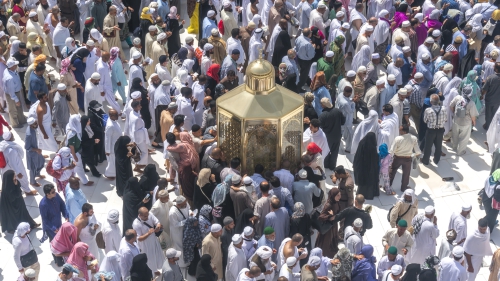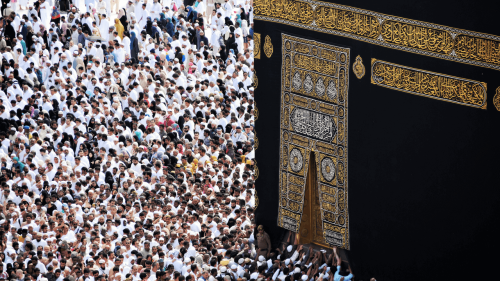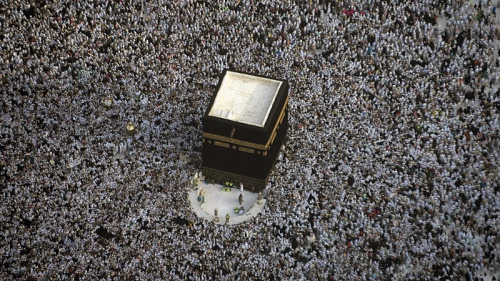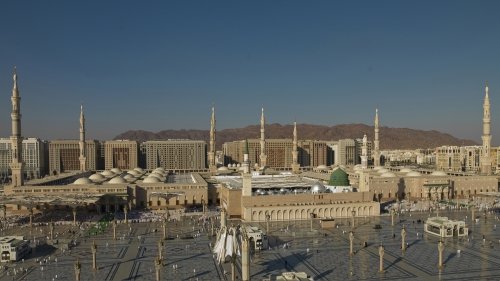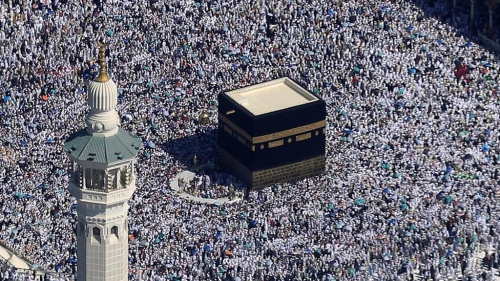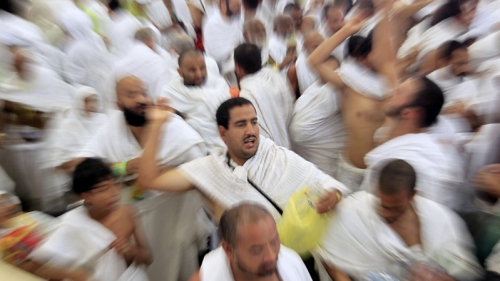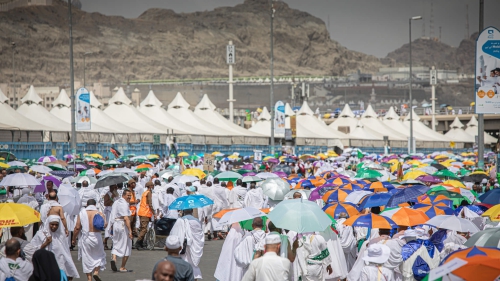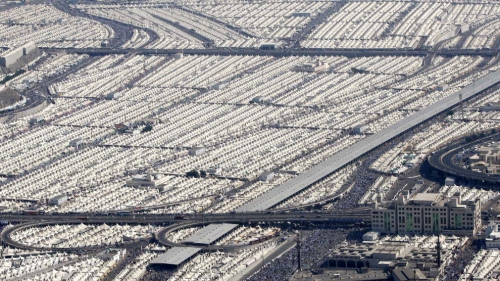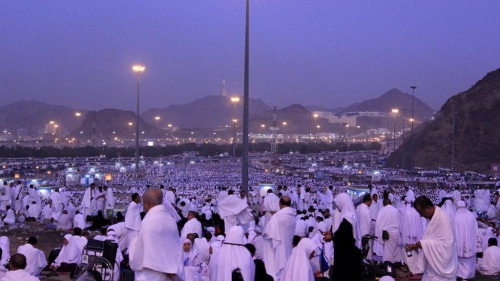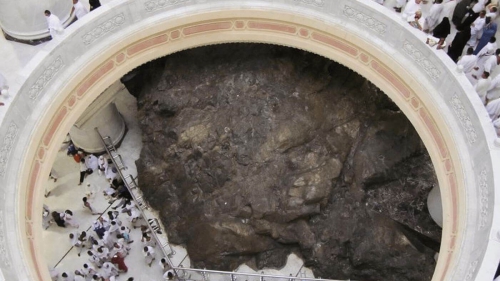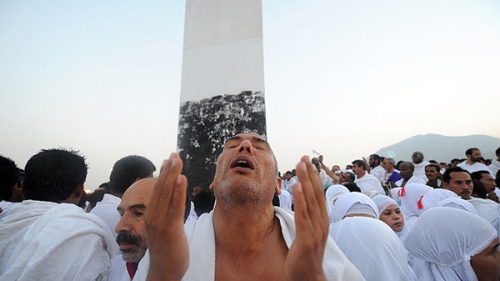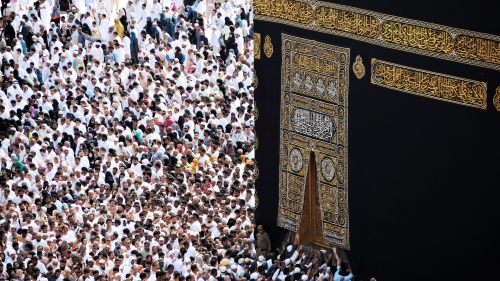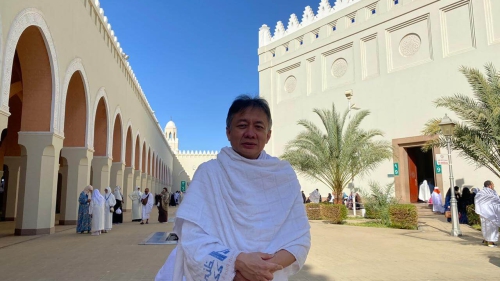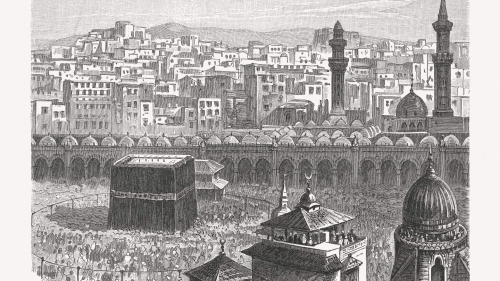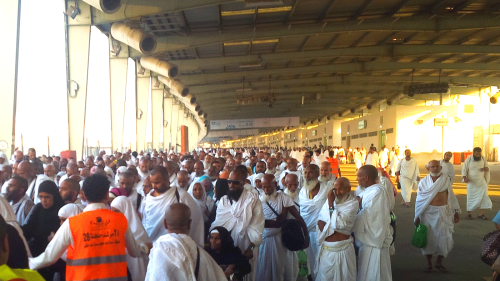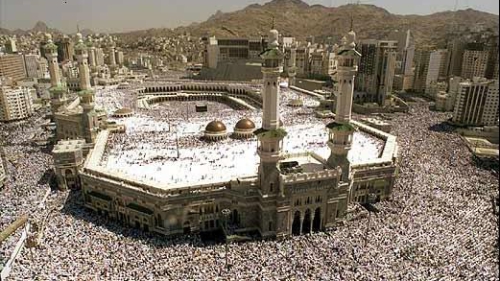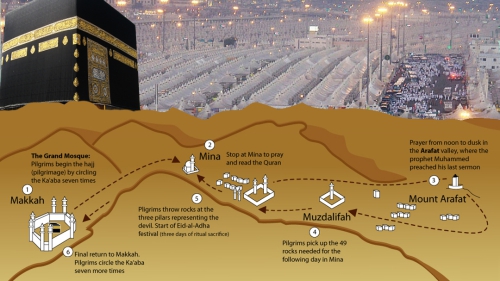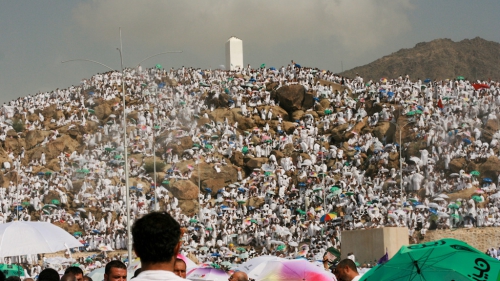The Spirituality of Hajj: Tawaf
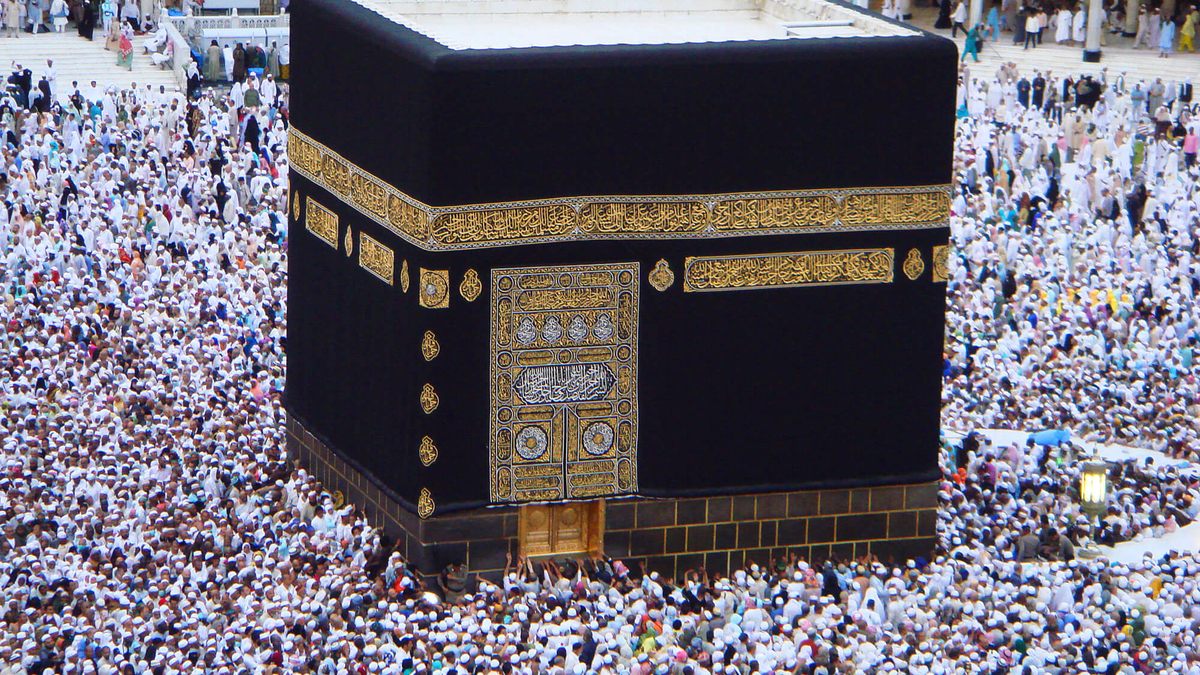
Tawaf and sa’y are two major components of Hajj carried out one after another. Tawaf is an act of circumambulating or walking around the Ka’bah in an anti-clockwise motion. Seven circles or circuits are to be accomplished.
Tawaf and sa’y represent the dynamism of life and its multidimensionality. Tawaf is derived from the root word “tafa” which means “to go from one place to another”, “to circle”, “to travel through”, “to roam”, and “to traverse and explore”. Ta’if is a person who performs tawaf around the Ka’bah, and tawwaf a person who travels a lot and continuously moves about. Tawwaf is an epithet given to Dhul Qarnayn, a legendary king who traversed the earth from the west (the setting of the sun) to the east (the rising of the sun).
Tawaf and sa’y are about vitality and perpetuation. Tawaf indicates both the earthly and cosmic energy and movement, while sa’y, predominantly, stands for the former. Tawaf’s movement is circular, which suggests unity, totality and infinity. It likewise implies the ongoing significance and power associated with the whole of creation and how everything is integrated into one.
In its capacity as the House of God, Ka’bah represents divinity. It is the source of all ontological meaning and consequence. It is likewise the source of all physical and spiritual life. A person should stay as close to the Ka’bah as possible - at once physically during tawaf and figuratively besides it - so as to draw on its munificence and use it as a means of approach unto its Owner.
The Prophet (pbuh) said that in each of the seven heavens there is a ka’bah which is frequented by the angels. The Ka’bah of the first heaven is called Bayt al-‘Izzah and that of the seventh heaven is called al-Bayt al-Ma’mur. Tawaf on earth, it follows, replicates scenes and ambiances from the heavens. It joins the universal chorus. To some, tawaf as well evokes the angels’ surrounding and circling of the Throne of Allah, “glorifying and praising their Lord” (al-Zumar, 75).
A person performing tawaf becomes part of the existential reality and purpose. He is constantly reminded of them and of his close relationship with them. Tawaf starts at the Ka’bah’s corner with the Hajar al-Aswad (Black Stone) and ends there. It is affirmed by the Prophet (pbuh) that the Black Stone was sent by Allah to the earth from Paradise.
Starting tawaf while facing the Black Stone, kissing it, if possible, or touching it with one’s hands, or pointing in its direction, and saying a supplication, reminds a pilgrim of his heavenly origins. He too, like the Black Stone, originated in Paradise. Moving then around the Ka’bah alludes to one’s life trajectory which must unfold within the vicissitudes of everyday life, but which cannot be so distracted thereby that one might be pulled away from his orbit in relation to the Ka’bah (divinity).
A pilgrim’s completion of each of seven circuits by arriving at the point of the Black Stone encourages a pilgrim to make sure that he and his life-story end again in Paradise. His journey should be like a circuit around the Ka’bah: from heavenly origins to the heavenly conclusion. Returning to Paradise – like returning to the Black Stone – would mean that a person’s life has come full circle. He ended where he had started.
That is why circling and circle as a geometric pattern also imply inclusiveness and focus. They suggest continuous progress towards success. Failure is not an option, nor partial success. These are antitheses of dynamism, stability and permanence.
The Prophet (pbuh) said that after descending from Paradise, the Black Stone was whiter than milk (or snow), then it was rendered black by the sins of the children of Adam. 1Al-Tirmidhi, Jami’ al-Tirmidhi, Book 9, Hadith No. 70. The destiny of man is the same. He too arrived from Paradise pure and with a clean slate. However, he blackened himself with the sins for which he and nobody else is responsible. Now what remains is that man works on bettering his state and reputation in order to facilitate his return to Paradise. The first step is repentance and the washing away of the sins as much as possible, followed by turning over a new leaf.
And there is no better place to start doing so than the sanctuary of Makkah with its Ka’bah, and no better occasion than Hajj and tawaf as one of its first and foremost rites. The Black Stone itself can play a role. It was for a reason that the Prophet (pbuh) said that touching the Black Stone removes sins. He in addition said regarding tawaf: “Whoever performs tawaf around this House seven times and he keeps track of it, then it is as if he freed a slave.” Also: “One foot is not put down, nor another raised (in tawaf), except that Allah removes a sin from a person and records a good merit for him”. 2Ibid., Book 9, Hadith No. 153.
The Ka’bah furthermore is like the sun and people are like stars revolving around it and floating, each in an orbit. The movement is progression from what a person is and what he intends, yet ought, to be. In all positions and during all times, a person maintains a steady distance with the Ka’bah or with Allah. The distance depends upon the path that a person has chosen in the system. The tawaf area (mataf) is like a magnetic field with the Ka’bah (the entire orb of divinity) in the centre. People are iron particles.
A person is attracted to the Ka’bah, but he does not rush towards it, or tries to enter it. He lets the Ka’bah enter him instead. His heart becomes the receptacle for the Ka’bah; yet his heart becomes a ka’bah. The interior of the Ka’bah is virtually empty. Thus, a person entering it will not change anything, neither in connection with the Ka’bah nor with the person himself. But the Ka’bah’s entering and conquering one's heart will mean the world for him.
According to Ali Shariati: “You do not touch the Ka’bah nor do you stop there. Everyone encircles the Ka’bah collectively. The movement is as one unit, one group of people. There is no individual identification, that is, as being a man or woman, nor black or white! It is the transformation of one person into the totality of a ‘people’. All of the ‘I’s’ join and become a ‘We’, establishing the ummah (community) with the aim of approaching Allah.” 3Ali Shariati, Hajj: Reflections on Its Rituals, (Chicago: Kazi Publication, 1978), p. 34.
He likewise said: “If you remain in the state of self-centeredness, you are not really a part of the tawaf circle. You will be like a visitor standing at the bank of a river, but not in it. Those who are detached from themselves are alive and moving collectively. Those who are not separated from themselves are stagnant and dead.” 4Ibid., p. 35.
While performing tawaf, pilgrims fixate their sights on the Ka’bah. But the Ka’bah is just a simple and unembellished cube, as its name implies. It is devoid of any worldly sophistication and adornment architecture-wise. Such is the case because in the kingdom of spirit these carry no weight whatsoever, especially if they are employed for some ungodly aims. Generally, on his spiritual journey man needs to partake of matter solely what is necessary and what constitutes a means. More than that is bound to hinder and hold back. Benchmarking in the two realms is different and dissimilar criteria apply.
Under no circumstances should ends be converted into means, and means into ends. Such is the sophistication of spirit that there is nothing in the material world that is genuinely similar to it and can be resorted to for the close analogy purposes. The best way, therefore, is to turn away from the failings of matter and stick to the innate human predispositions towards simplicity, purity, wholesomeness, equilibrium and harmony. When adequately employed, these are closer to the world of spirit than to the world of matter.
This strategy is used with regard to the structural appearance of the Ka’bah. The building is so simple, yet so complex and refined in terms of message. It represents, “houses” and radiates divinity that overcomes the people. The same holds true as regards every symbol, rite, or sign of Allah. People can sense their extraordinary quality and appeal, but cannot put what they feel into words. They merely know that they cannot get bored with, nor satiated by, the profusion of spirit.
For instance, a person reads a verse or a short chapter from the Qur’an thousands of times, but every time it feels different and is like the first time - for indeed the treasures of God are inexhaustible. Another person may pronounce “All praise is due to Allah, the Lord of the Worlds” (al-Fatihah, 2) as a verse from the Qur’an, in which case he will feel the power – and beauty - of God’s holy Words, consciously or otherwise. However, if the same person pronounces the same formula (All praise is due to Allah, the Lord of the Worlds), albeit not intending it as God’s Words but rather as his own construction as part of his daily conversations, he will feel almost nothing about it. The reason for this is straightforward: the former is infused with the life-force of the highest levels of the heavenly dominion, and the latter is not.
This applies to the Ka’bah too. People look at it a thousand times, but every time it feels different and is like the first time. Human capacities are nothing when it comes to appreciating and engaging in absolute beauty, greatness and worth. Man is left with no other choice but to be filled with awe, veneration, and to quiver. For this reason is the architectural minimalism of the Ka’bah grander than the architectural and artistic intricacy of all the “masterpieces” erected throughout history for the sake of glorifying man (humanism-cum-science) and matter (materialism-cum-liberalism). The two are not even in the same league.
That the Ka'bah was originally built as an unpretentious stone structure was apt, making it appropriate to its time, place and people. The Ka'bah is in complete harmony with its natural environment. It grows, so to speak, out of the site. It at once symbolizes and reverberates Makkah's attribute as haram. Hence, it seems naturally beautiful, hence sustainable and even organic, satisfying the physical and spiritual needs. It exudes an aura of veneration, lure, awe and spiritual and psychological serenity.
Due to all this, plus the supplication of Ibrahim that the believing human hearts incline towards it, the Ka'bah is dearly loved and longed for. Because it signifies the result of a direct heavenly initiative and involvement, the Ka'bah's intrinsic charm and beauty are beyond description. Lost for words, while watching, touching, or circumambulating it, most people tend to give in to the stream of profuse, albeit incommunicable spiritual, psychological and even intellectual emotions the circumstances generate. As if they sense that being silent and self-effacing, acknowledging the supernatural and divine overarching character of the Ka'bah - while juxtaposing it with their flaws, inadequacies and this-worldliness - is the best and most profitable mood. Any other approach is set to divest visitors and worshippers of some of the boons they have come for and were instinctively looking forward to procuring.
Feeling hopeless, some people resort to closing their eyes and trying to "watch" and "embrace" the Ka'bah rather by means of their elated hearts and ecstatic souls. That way, all the inapt and under the circumstances "impairing" physical senses are temporarily shut, and through that metaphysical God-granted capacity that graces each and every human creature, one's self is attempted to be elevated to a higher spiritual vintage point from where the Ka'bah could be "seen" and experienced better. Losing completely one's self inside the spiritual domains of the Ka'bah, it goes without saying, is the best way for a person to find and experience the quintessence of his own being, existence as a whole and the Ka'bah phenomenon itself.
If the Ka’bah is sanctified, so is its tawaf and the atmosphere the latter generates. As a result, a person performing tawaf must be cleansed of all major and minor physical impurities. He must be up to the task. Not only that; the Prophet (pbuh) said that tawaf around the Ka’bah is similar to Salat (prayer) except that people can talk during it. “So whoever talks in it, then let him not say but good.” 5Al-Tirmidhi, Jami’ al-Tirmidhi, Book 9, Hadith No. 154. Thus, just like in Salat, a person making tawaf is expected to “face” the Ka’bah and to capitalize on the opportunity to advance towards his ultimate destiny. All this is intended to optimize the function of the Ka’bah and its tawaf, and to prepare the people for things to come.
It is interesting to note that despite everything, there is no particular dhikr (remembrance of God) for tawaf. A pilgrim may read the Qur’an or say any dhikr he wants. This is important because dhikr, supplications and reciting the Qur’an should be placed in the service of aiding and boosting one’s experience of tawaf. People come from diverse religious, intellectual and socio-cultural backgrounds, hence there should be no such thing as a one-size-fits-all approach. What is inspiring and motivating for some, it is not so much for others.
People should feel free and have recourse to any dhikr, supplications and Qur’an recitation templates they want and feel can improve their knowledge and experiences. There are yet those who prefer contemplation – the activities of the mind and the soul at the expense of the tongue - above everything else. What is important is that the dimensions of a pilgrim – the physical, intellectual, emotional and spiritual – stay together and in unison work towards the same ends. A pilgrim is at loss if his dimensions are fragmented and incoherent, clouding his awareness and marring his sensations.
It is inappropriate – as it happens all the time unfortunately – that upon pilgrims certain dhikr, supplications and Qur’an reading patterns are rigidly imposed. Those pilgrims are navigated through the tawaf tide and asked to say or recite what they neither know nor understand. They blindly cling to it believing that such is the way and so, is the exclusive virtue.
Those people and their instructors are the proponents of deadening formalism and ritualism, which is a small manifestation of a much larger problem (the tip of the iceberg). For them, tawaf and the rest of Hajj are merely a set of dry and superficially meaningful ceremonies. The object is just to do, not really comprehend and live through the events. They travel through the tawaf stream like a traveller who sleeps through his night journey. He wakes up when everything is over.
In tawaf a pilgrim wears the upper sheet of ihram in such a way that it goes under his right armpit and over the left, exposing thus the right shoulder. Of the seven circles around the Ka’bah, a pilgrim should hasten, or jog, during the first three and walk during the remaining four circles. There is a historical reason for this, which persisted in order for the subsequent generations of Muslims to share a form and a feeling similar to that observed and felt by early Muslims.
A companion of the Prophet (pbuh), Abdullah Ibn ‘Abbas, reported that when the Prophet (pbuh) and a company of Muslims came from Madinah to Makkah to perform ‘Umrah (the lesser pilgrimage) they were weakened somewhat by the fever in Madinah. Makkah was still in the hands of the polytheistic Quraysh and they wanted to employ this as a propaganda material against Muslims. They used to say to their countrymen: “People weakened with fever have come to you and they are afflicted with evil.”
Allah informed the Prophet (pbuh) about this and he commanded the Muslims to jog through the first three circuits of tawaf. It is believed that the same reason was behind exposing their right shoulders. The Prophet (pbuh) wanted to show the Quraysh that the opposite of what they were alleging was true. The initiative, without a doubt, was part of psychological warfare. Having witnessed the spectacle, the Quraysh said: “Are those the people you said are weak because of the fever? They are stronger and sturdier than us.” The Prophet (pbuh) did not instruct the Muslims to jog all through the seven circuits of tawah lest they overexert themselves. 6As-Sayyid Sabiq, Fiqh us-Sunnah – Hajj and ‘Umrah, (Riyadh: International Islamic Publishing House, 1992), p. 77. Al-Bukhari, Sahih al-Bukhari, Book 26, Hadith No. 672.
The way tawaf is performed remains a sign of strength and endurance ever since. It is reminiscent of life struggles that await believers in their lives. As the followers of the truth, their tests will not end, in that Satan and his armies never sleep. Therefore, jihad (a comprehensive struggle to make the Word of God supreme) should be the top priority of believers and they should be ever-ready. Their life interests, activities, possessions and even the ways they dress and behave ought to serve as the testaments of their inner state. The Prophet (pbuh) said: “The strong believer is better and more beloved to Allah than the weak believer, although both are good. Strive for that which will benefit you, seek the help of Allah, and do not feel helpless.” 7Ibn Majah, Sunan Ibn Majah, Introduction, Hadith No. 79.
One should not forget the importance of following in the footsteps of and emulating the example of the Prophet (pbuh). Such is an unmistaken sign of true faith. ‘Umar bin al-Khattab said: “There is no reason for us to do ramal (i.e. jogging during the first three circles of tawaf) except that we wanted to show off before the pagans, and now Allah has destroyed them. Nevertheless, the Prophet did that and we do not want to leave it.” 8Al-Bukhari, Sahih al-Bukhari, Book 26, Hadith No. 675.
As a rule, Hajj rituals, big and small – yet all Islamic rites and ceremonies - are learned from the Prophet (pbuh) exclusively. He himself used to lay emphasis on that throughout his Hajj. Once he said: “Take your rituals from me. I do not know whether I will be able to perform another Hajj after this one.” 9As-Sayyid Sabiq, Fiqh us-Sunnah – Hajj and ‘Umrah, p. 103. As per a report narrated by Imam al-Bukhari, Abdul-Malik bin Marwan wrote to al-Hajjaj that he should follow the companion ‘Abdullah bin ‘Umar in all the ceremonies of Hajj. 10Al-Bukhari, Sahih al-Bukhari, Book 25, Hadith No. 144. He did so because Abdullah bin ‘Umar was well-known for following the Prophet (pbuh) in the minutest details. He was al-Hajjaj’s sure thing in matters of uncertainty. Following Abdullah bin ‘Umar was tantamount to following the Prophet (pbuh).
Parenthetically, scholars are almost unanimous that revealing the right shoulder and jogging through the first three rounds of tawaf (ramal) is required only during the first tawaf of Hajj, which is tawaf al-qudum (tawaf of arrival). Such is the first thing a pilgrim does upon his arrival in Makkah and in the Holy Mosque. With it he greets the place and occasion – and is greeted by them. He announces his arrival and readiness to engage in the impending tasks. He demonstrates that he is sufficiently healthy and strong. Revealing the right shoulder and doing the ramal is not required during the subsequent tawaf al-ifadah (tawaf of visiting), tawaf al-wida’ (farewell tawaf) and the voluntary tawaf. In these three types of tawaf pilgrims wear their regular clothes, hence especially revealing the right shoulder becomes unrealistic.
The above-lessons should likewise be imparted to pilgrims as part of their Hajj education, motivation and guidance. They are to be galvanized thus, prompting them to pledge to spend the remainder of their lives not merely as the servants, but also as soldiers of the truth. They can do that right during tawaf and in the vicinity of the Ka’bah, or at any stage of the revolutionary experience of Hajj.
The lessons have the potential to enhance pilgrims’ sense of purpose. Their sense of time, place and history will also be brought into focus, revealing and further augmenting their belonging to the universal community of believers moving across times, lands and ideas. Fulfilling their human need of feeling that they belong will go a long way towards the opening of new avenues for the enrichment of pilgrims and of their confidence-building.
As a sign of this crowning virtue of belonging, a pilgrim, having completed tawaf, offers a two-rak’ah (unit) prayer at the station of Prophet Ibrahim – the father of prophets and an ummah (a total nation, leader and model). Not to speak of the fact – in respect of quantity - that one prayer in the Holy Mosque (al-Masjid al-Haram) is better than one hundred thousand prayers elsewhere, as revealed by the Prophet (pbuh). 11 Ibn Majah, Sunan Ibn Majah, Book 5, Hadith No. 604.
Next, a pilgrim moves on to perform sa’y.
A series of articles adapted from the latest book by Dr. Spahic Omer, "The Spirituality of Hajj".
Footnotes
Topics: Hajj, Kabah, Tawaf Values: Spirituality Channel: Hajj - Day 1
Views: 9959
Related Suggestions






